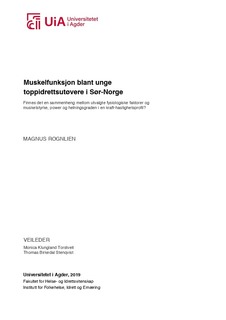| dc.description.abstract | Background: Muscle strengthand poweris a determining feature of performance in many different sports and thephysiologicalfactors that affect muscle functionare many. Previous studies have mostly concernedadult athletes, while researchfeaturing young elite athletes or differences between sports have been scarce. Purpose: The study’s purposeis to investigate possibleconnectionsbetween physiological factors such as resting metabolic rate, protein intake, and fat-free mass and muscle functionamong young elite athletes in southern Norway.Differences between sport-groupswere alsoinvestigated. Method: A total of 36young elite athletes (24 endurance athletes, 12 ball game athletes) participated in this study. Body composition was measured with dual-energy x-ray absorptiometry, resting metabolic rate with indirect calorimetry, protein intake was determined by asemi-structured recallinterview and musclefunctionwas measured with a pneumatic leg press. Results: Resting metabolic rate correlated significantlypositivewith several strength variables, while relative resting metabolic rate had a significant negative correlation. Both fat-free mass and protein intake correlated significantly with several strength variables. The slope did not correlate significantlywith any variables, and no significant differences were found between sport-groups among any of the variables. Conclusion: The results indicate aconnection between resting metabolic rate, protein intake, fat-free mass and muscle functionin young elite athletes in southern Norway, though not between the degree of slope andresting metabolic rate, protein intake or fat-free mass. Itmay appear that fat-free mass is a factor thataffects muscle functionin young elite athletes, as well as, amongst others, absoluteand relative resting metabolic rate.No differences were found between the sport-groups. Keywords: Resting metabolic rate, Fat-free mass, Proteinintake, young elite athletes | nb_NO |

